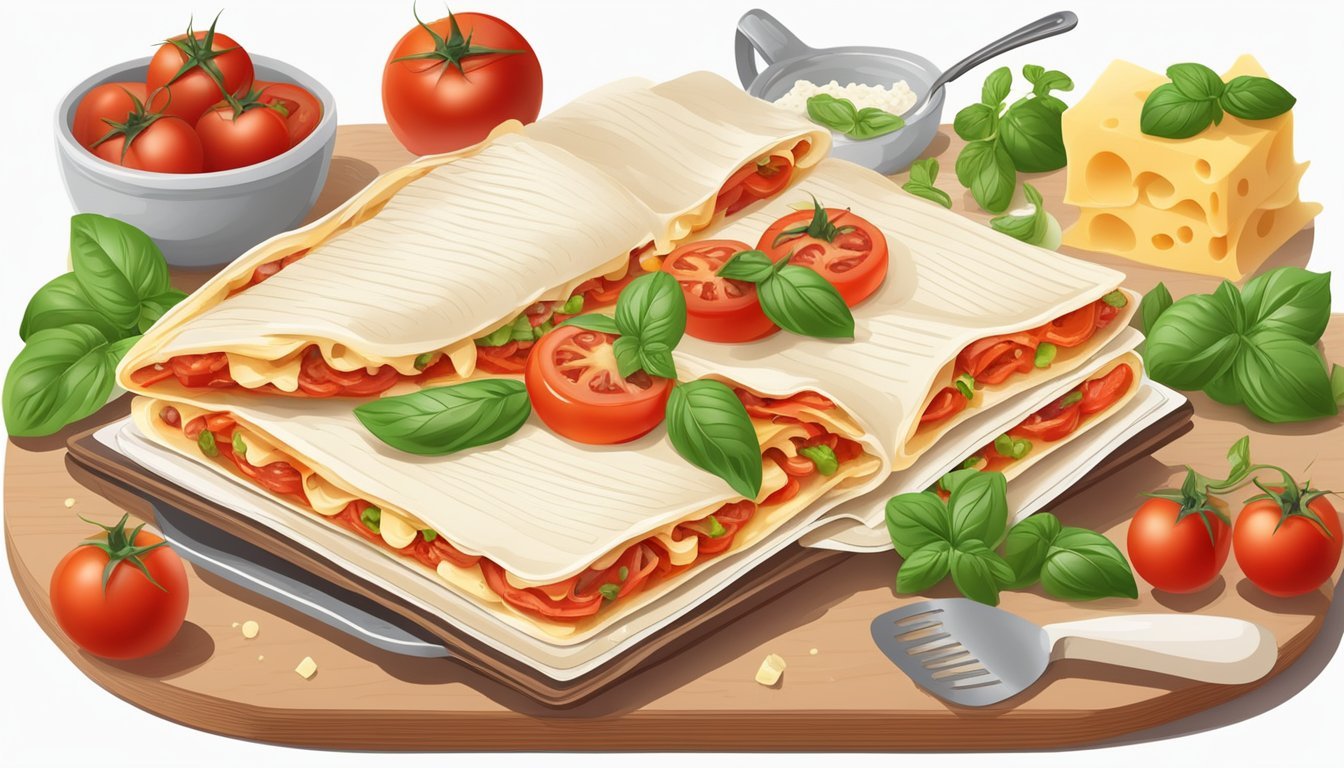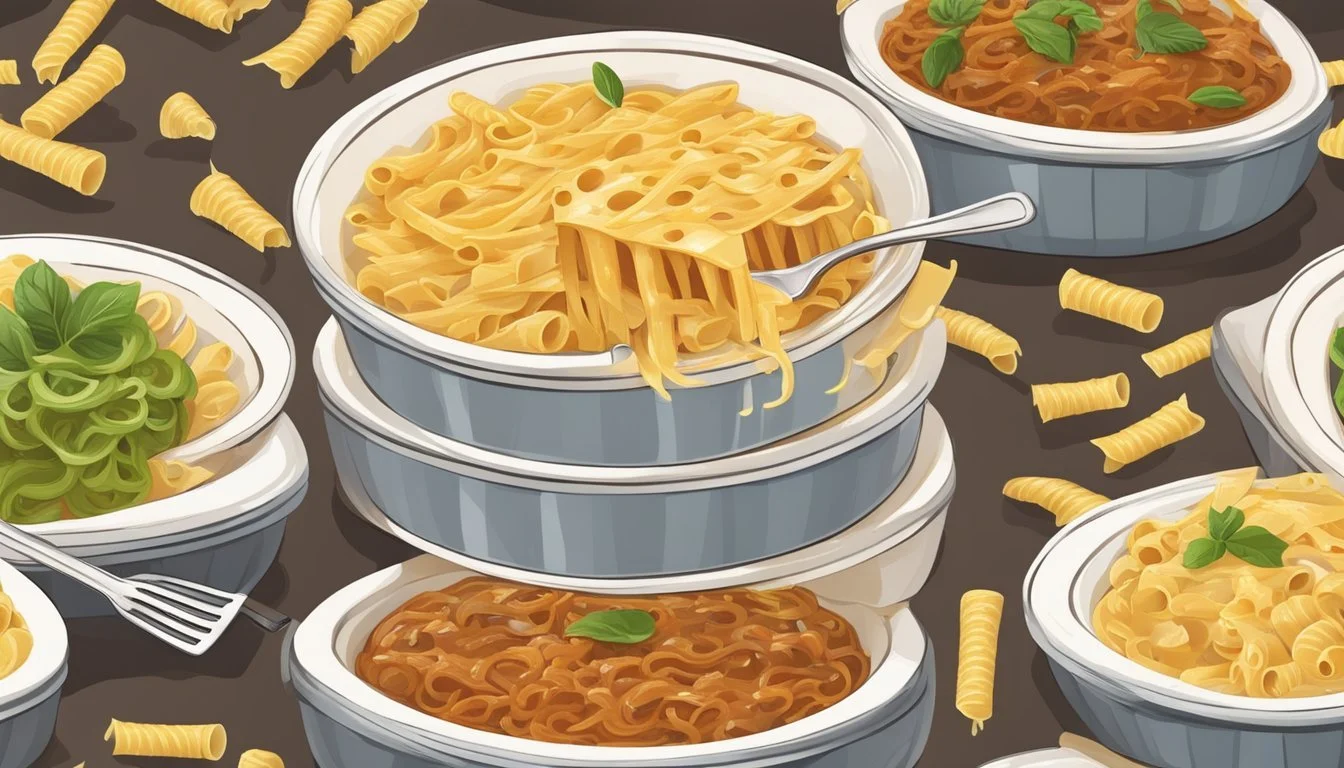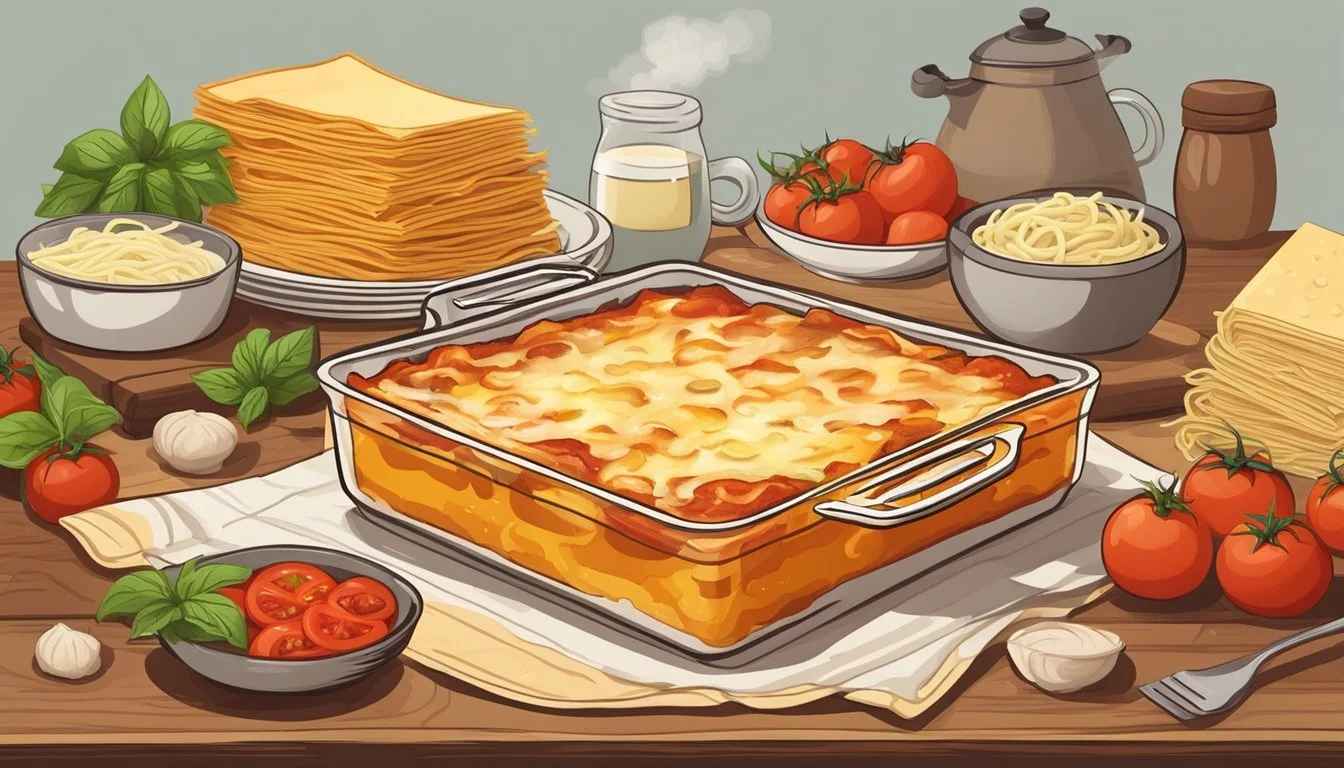How Do You Eat a Lasagna?
Mastering the Art of Italian Dining
Lasagna is a quintessential Italian dish that has found its way into the hearts of people worldwide. This layered pasta masterpiece, traditionally made with sheets of lasagna noodles, generous amounts of cheese, and a rich meat sauce, presents a fulfilling meal that is both versatile and comforting. Its preparation can be as straightforward or as involved as one chooses, making it a staple for both weeknight dinners and special occasions. The versatility of lasagna allows for a variety of fillings, including vegetables like spinach, which can be incorporated into the dish for an added nutritional boost.
To create a memorable homemade lasagna, it's crucial to understand the balance of flavors and the importance of quality ingredients. A robust tomato sauce, well-seasoned with herbs such as basil (how long does basil last?) and oregano, forms the base of many lasagna recipes. Alternating layers of this sauce, pasta sheets, and a mixture of cheeses such as ricotta, mozzarella, and Parmesan, are essential. Each layer contributes to the overall texture and taste, culminating in a rich and satisfying dish. For those seeking a personal touch, incorporating a bechamel sauce or exploring variations in the cheese and meat used can make the recipe distinctly their own.
When it comes to consuming this delightful dish, lasagna is typically served in square or rectangular portions, often accompanied by a simple side such as a green salad or a vegetable soup like minestrone. The method of serving is not just about presentation; it allows the layers to set and the flavors to meld together, ensuring each bite is as delectable as the last. In its ideal state, lasagna is indulged in when the cheese is melted and bubbly, yet not burnt, and the pasta is tender, providing a delightful contrast with the richness of the sauce and the creaminess of the cheeses.
Selecting Ingredients
Crafting the perfect lasagna requires precise ingredient choices, from the texture of the pasta to the blend of cheeses and the robustness of the meat sauce. Each component contributes to the dish’s depth of flavor and overall success.
Choosing the Right Pasta
For lasagna, options vary from traditional dried egg pasta to no-boil noodles. Fresh pasta (how long does fresh pasta last?) sheets offer a delicate texture but require precooking, whereas no-boil noodles save time and absorb flavors more during baking. Opt for high-quality Italian brands for authenticity.
Meat Selection
The meat layer is pivotal for flavor. Ground beef is a classic for its rich taste, while combining it with sausage or pork enhances complexity. Ensure meats are browned properly to deepen the flavor profile before layering.
Cheese Varieties
A trio of cheeses is ideal: mozzarella for meltiness, ricotta for creaminess, and Parmesan for a savory bite. For a sharper taste, a sprinkling of cheddar can be considered. Each cheese should be fresh and full-fat for the best texture and flavor.
Tomato Sauce Preparation
The sauce is the lasagna's soul. Start with a base of olive oil and garlic, then add crushed tomatoes, tomato paste, and a preferred marinara if desired. Simmer to allow flavors to meld together, considering a touch of sugar to balance acidity.
Herbs and Spices
Depth in lasagna comes from the careful addition of herbs such as basil, oregano, parsley, and thyme. Season with black pepper and, if preferred, a pinch of red pepper flakes for heat.
Additional Vegetables
Beyond the basics, incorporating vegetables like onion, celery, carrots, broccoli, peas, or kale can add both flavor and nutritional value to lasagna. These should be sautéed until tender before being added to the layers.
Creating the Béchamel
A creamy béchamel sauce, also known as white sauce, may replace or accompany the cheese layer. It’s made by whisking butter and flour to create a roux, then slowly incorporating milk until thickened. Finish with a hint of nutmeg for classic flavor.
Assembling the Lasagna
Assembling a lasagna involves meticulously layering various ingredients to create a harmonious blend of flavors and textures. Precision in layer order and ingredient preparation ensures a lasagna that holds its structure and offers an ample taste with each bite.
Layering the Ingredients
One begins by spreading a thin layer of meat sauce in the bottom of a baking dish to prevent the lasagna noodles from sticking. It is crucial to arrange the noodles side by side without overlapping, as this could lead to a chewy texture. Upon covering the base with noodles, one adds a layer of cheese—typically including ricotta mixed with egg to aid in setting—followed by more meat sauce. These steps are repeated, usually ending with a generous layer of shredded mozzarella and Parmesan cheeses.
Order of Layers:
Meat sauce
Lasagna noodles
Ricotta cheese mixture
Meat sauce
Mozzarella and Parmesan cheeses
Using No-Boil Noodles
For those choosing no-boil noodles, the pasta absorbs liquid from the sauce during the baking process, eliminating the need to pre-cook them. Ensure the oven is preheated to the correct temperature, commonly around 375°F, and that the lasagna is covered with aluminum foil to prevent the top from over-browning. No-boil noodles often require a slight adjustment in liquid ratios to accommodate their absorbency and typically extend the baking time slightly.
No-Boil Noodles Tips:
Increase sauce moisture
Cover with foil to retain steam
Adjust baking time as needed
Adding Garnishes and Sides
Garnishing lasagna with fresh herbs like basil or oregano just before serving adds a burst of color and freshness. Accompany the dish with a simple arugula (how long does arugula last?) salad or a loaf of crusty bread for textural contrast and to round out the meal. It is important to balance the hearty richness of the lasagna with lighter side dishes that complement its robust flavors.
Suggested Sides:
Bread: Crusty loaf, garlic bread
Salad: Arugula, caesar, or Italian mixed greens
Cooking Techniques
Creating the perfect lasagna involves mastery of cooking techniques that ensure a well-baked dish with optimal flavor and texture. From the oven's role in baking to the best practices for storage, these steps are crucial in lasagna preparation.
Baking the Lasagna
When baking lasagna, preheating the oven to the correct temperature is essential. The ideal heat for cooking lasagna is 375°F (190°C), which allows for even cooking without burning the edges. Lasagna should bake covered with aluminum foil for about 30 minutes, ensuring the heat circulates properly and the noodles soften. Afterward, removing the foil and continuing to bake for an additional 10-15 minutes gives the cheese on top the opportunity to turn a delightful golden brown and bubbly. It is recommended to place the baking dish on a wire rack positioned in the middle of the oven to promote consistent heat distribution.
Here's a step-by-step guide:
Preheat oven to 375°F (190°C).
Cover lasagna with foil and bake for 30 minutes.
Remove foil and bake for another 10-15 minutes until cheese is golden.
Let it rest on a wire rack before serving to allow the layers to set.
Making Ahead and Storing
Making lasagna ahead of time is an efficient way to manage meal preparations. The assembler can prepare the lasagna, cover it with aluminum foil, and refrigerate it for up to two days before baking. To freeze lasagna, one should wrap the dish securely with foil and it can be stored for a couple of months. Before baking a frozen lasagna, it's best to thaw it first in the refrigerator to shorten the cooking time and ensure even heating.
For leftovers, proper storage is key to maintaining taste and quality. Lasagna should be kept in an airtight container and can be refrigerated for up to five days. Reheat portions in the oven or microwave, ensuring a palatable meal each time.
A quick reference for storing:
Refrigerate unbaked lasagna: Up to 2 days
Freeze unbaked lasagna: Several months
Refrigerate leftovers: Up to 5 days
Pairing a glass of red wine with the lasagna complements the flavors and can enhance the dining experience.
Serving Suggestions
When serving lasagna, the goal is to deliver it to the plate with neat edges and warm layers. Choosing the right combination of sides and wines enhances the overall dining experience.
Cutting and Plating
After the lasagna has been removed from the oven, it should rest in the baking dish for about 15 minutes. This allows the layers to set, making it easier to cut cleanly. Using a sharp knife or spatula, lasagna should be cut into squares or rectangles as per the size of the portions desired. For an ideal presentation, lasagna is best served on a heated plate to maintain its temperature.
Pairing with Wine and Sides
Wine: A robust red wine, such as a Chianti or a Merlot, typically pairs well with lasagna, especially if the lasagna features a meat-based or tomato-rich sauce.
Sides: Opt for lighter sides to balance the richness of lasagna.
List of Simple Side Options:
Salad: A fresh green salad, dressed with a vinaigrette.
Bread: Garlic bread or breadsticks.
Vegetables: Roasted zucchini or green beans almondine.
For a satisfying meal, choose a couple of side dishes that will complement the flavors without overwhelming the palate.
Variations of Lasagna
Exploring the world of lasagna reveals a wealth of variations that offer a delightful twist on this classic Italian dish. Each recipe provides a unique combination of flavors and textures, catering to a range of dietary preferences and palates.
Alternative Lasagna Recipes
Traditional Italian Lasagna: Often referred to as Lasagne alla Bolognese, this recipe is a staple in Italian cuisine, characterized by its rich layers of egg pasta sheets, hearty meat ragù, and creamy béchamel sauce. While some recipes may adjust the meat types or seasoning proportions, the essence of traditional Bolognese lasagna remains a beloved classic worldwide.
American-Italian Lasagna: It adapts the Italian foundation but typically uses more cheese, sometimes incorporating ricotta and mozzarella for a creamier, denser feel. The sauces are often heavier on tomatoes, leading some to include a layer of marinara or tomato sauce alongside or in place of the Bolognese sauce.
Vegetarian and Gluten-Free Options
Vegetarian Lasagna (What wine goes well with vegetarian lasagna?): It sees the replacement of meat with vegetables such as spinach, zucchini, mushrooms, or even the less common radicchio. These ingredients not only imbue the dish with distinct flavors but also add nutritional value, making it a satisfying option for those preferring plant-based meals.
Gluten-Free Lasagna: They often utilize pasta sheets made from rice flour or other gluten-free alternatives. These adaptations ensure that individuals with gluten sensitivities can still enjoy lasagna without compromising on taste or texture.
Using Different Sauces
Lasagna recipes can be further diversified by experimenting with various sauces.
Marinara Sauce: A simple tomato-based sauce, seasoned with garlic, basil, and sometimes a hint of red pepper flakes, can replace the traditional bolognese for a lighter lasagna.
Ragù Variations: While the classic Bolognese sauce is a ragù, variations can include changing the meat or adding different vegetables, wine, or herbs to create a unique flavor profile.
By embracing these variations, home cooks and chefs alike keep the tradition of lasagna alive while allowing for creativity and personalization in every recipe.
Understanding Lasagna History
Lasagna is a dish steeped in rich history, with variations that trace back to ancient times. It is broadly known as a traditional Italian dish, but its origins are a mosaic of cultural influences. The term "lasagna" is derived from the Greek "Laganon," a term used for the first known forms of pasta, which consisted of layers of pasta and sauce.
Historical Evolution:
Antiquity: The inception of lasagna can be linked to the Etruscans who made "laganum," a flat sheet of dough that was boiled and seasoned.
Rome: The concept of layered dough carried into Roman cuisine with the term "lagana."
Middle Ages: Over the centuries, the dish evolved with different regions in Italy adopting unique interpretations.
Italian Variation:
The singular "lasagna" represents a southern Italian version, whereas the northern Italian counterpart is referred to as "lasagne." A notable personality, Chef Giorgio Locatelli, is celebrated for his contributions to Italian cuisine, including modern renditions of this classic dish.
Traditional Recipe Elements:
Pasta Sheets: Thin dough, often inclusive of egg and sometimes spinach.
Layers: Alternating with ragù (meat sauce), béchamel sauce, and sometimes vegetables.
Cheese: Topped with Parmigiano-Reggiano, the lasagna is then baked to achieve a golden crust.
Through centuries, lasagna has remained a culinary staple, adopting regional flavors and cooking styles. Today's Italian lasagna is renowned for its rich, comforting layers, each preserving a piece of history in every bite.
Cookbook Recommendations
For those seeking to refine their lasagna-making skills or to explore new variations, there are cookbooks that come highly recommended.
"Lasagna: A Baked Pasta Cookbook" by Anna Hezel and The Editors Of Taste ranks highly among them. With a 4.5-star rating and promising a new viewpoint on the classic dish, this hardcover offers bold and creative lasagna recipes. One can find 50 different recipes that might change the way one thinks about lasagna, catering to a range of tastes and preferences.
Avid chefs might also look into works by the famed Rao's restaurant, known for their classic Italian cooking. They have published several cookbooks which, while not exclusively focused on lasagna, provide insight into crafting authentic Italian lasagna recipes alongside other traditional dishes.
For a compact list of resources, consider the following:
Title Author(s) Features Lasagna: A Baked Pasta Cookbook Anna Hezel, The Editors Of Taste 50 varied lasagna recipes Rao's Cookbook Frank Pellegrino Authentic Italian recipes, including classic lasagna
Each cookbook offers a unique approach. Whether one prefers the comfort of a traditional lasagna or is eager to try something unconventional, such as fried lasagna bites or low-carb options, these books provide an abundance of recipes.
As always, individuals should pick a cookbook that aligns with their culinary skills, interests, and dietary needs. The aforementioned recommendations stand as a testament to the enduring love for lasagna and the diversity of ways it can be enjoyed.









